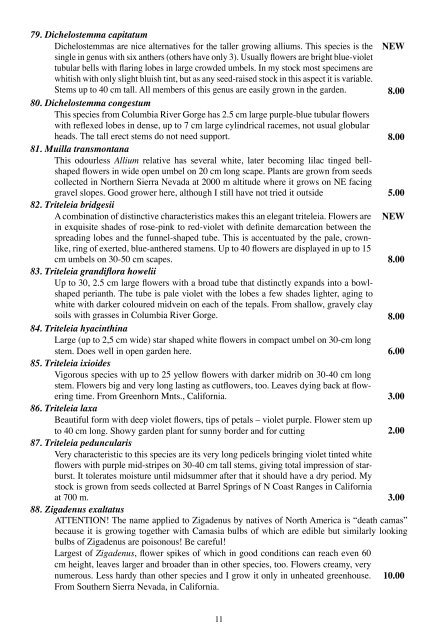1. Iris species nova - Starweaver's Gems from Earth and Sky
1. Iris species nova - Starweaver's Gems from Earth and Sky
1. Iris species nova - Starweaver's Gems from Earth and Sky
You also want an ePaper? Increase the reach of your titles
YUMPU automatically turns print PDFs into web optimized ePapers that Google loves.
79. Dichelostemma capitatum<br />
Dichelostemmas are nice alternatives for the taller growing alliums. This <strong>species</strong> is the NEW<br />
single in genus with six anthers (others have only 3). Usually flowers are bright blue-violet<br />
tubular bells with flaring lobes in large crowded umbels. In my stock most specimens are<br />
whitish with only slight bluish tint, but as any seed-raised stock in this aspect it is variable.<br />
Stems up to 40 cm tall. All members of this genus are easily grown in the garden. 8.00<br />
80. Dichelostemma congestum<br />
This <strong>species</strong> <strong>from</strong> Columbia River Gorge has 2.5 cm large purple-blue tubular flowers<br />
with reflexed lobes in dense, up to 7 cm large cylindrical racemes, not usual globular<br />
heads. The tall erect stems do not need support. 8.00<br />
8<strong>1.</strong> Muilla transmontana<br />
This odourless Allium relative has several white, later becoming lilac tinged bellshaped<br />
flowers in wide open umbel on 20 cm long scape. Plants are grown <strong>from</strong> seeds<br />
collected in Northern Sierra Nevada at 2000 m altitude where it grows on NE facing<br />
gravel slopes. Good grower here, although I still have not tried it outside 5.00<br />
82. Triteleia bridgesii<br />
A combination of distinctive characteristics makes this an elegant triteleia. Flowers are NEW<br />
in exquisite shades of rose-pink to red-violet with definite demarcation between the<br />
spreading lobes <strong>and</strong> the funnel-shaped tube. This is accentuated by the pale, crownlike,<br />
ring of exerted, blue-anthered stamens. Up to 40 flowers are displayed in up to 15<br />
cm umbels on 30-50 cm scapes.<br />
8.00<br />
83. Triteleia gr<strong>and</strong>iflora howelii<br />
Up to 30, 2.5 cm large flowers with a broad tube that distinctly exp<strong>and</strong>s into a bowlshaped<br />
perianth. The tube is pale violet with the lobes a few shades lighter, aging to<br />
white with darker coloured midvein on each of the tepals. From shallow, gravely clay<br />
soils with grasses in Columbia River Gorge. 8.00<br />
84. Triteleia hyacinthina<br />
Large (up to 2,5 cm wide) star shaped white flowers in compact umbel on 30-cm long<br />
stem. Does well in open garden here. 6.00<br />
85. Triteleia ixioides<br />
Vigorous <strong>species</strong> with up to 25 yellow flowers with darker midrib on 30-40 cm long<br />
stem. Flowers big <strong>and</strong> very long lasting as cutflowers, too. Leaves dying back at flowering<br />
time. From Greenhorn Mnts., California. 3.00<br />
86. Triteleia laxa<br />
Beautiful form with deep violet flowers, tips of petals – violet purple. Flower stem up<br />
to 40 cm long. Showy garden plant for sunny border <strong>and</strong> for cutting 2.00<br />
87. Triteleia peduncularis<br />
Very characteristic to this <strong>species</strong> are its very long pedicels bringing violet tinted white<br />
flowers with purple mid-stripes on 30-40 cm tall stems, giving total impression of starburst.<br />
It tolerates moisture until midsummer after that it should have a dry period. My<br />
stock is grown <strong>from</strong> seeds collected at Barrel Springs of N Coast Ranges in California<br />
at 700 m. 3.00<br />
88. Zigadenus exaltatus<br />
ATTENTION! The name applied to Zigadenus by natives of North America is “death camas”<br />
because it is growing together with Camasia bulbs of which are edible but similarly looking<br />
bulbs of Zigadenus are poisonous! Be careful!<br />
Largest of Zigadenus, flower spikes of which in good conditions can reach even 60<br />
cm height, leaves larger <strong>and</strong> broader than in other <strong>species</strong>, too. Flowers creamy, very<br />
numerous. Less hardy than other <strong>species</strong> <strong>and</strong> I grow it only in unheated greenhouse. 10.00<br />
From Southern Sierra Nevada, in California.


